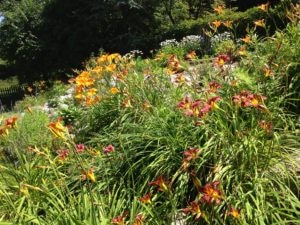Hello Fellow Readers,
I visited Sandy in Sparta, NJ, not long ago, who was concerned about her evergreens. We planted Microbiota decussata, commonly called Siberian cypress, along a rocky embankment to help with erosion. And to serve as a feathery evergreen groundcover, a softer solution to the prickly creeping juniper is often used.
Some of the Microbiota have clumps of dead branches. If they were along the driveway, I’d blame it on salt. I learned from an arborist there’s more evergreen decline due to the excessive rains the last two years causing soil compression inhibiting oxygen to the roots. We pruned each dead branch to the next stem joint. If they ran sprinklers in their lawn, I’d ask to be sure to prevent water from over-spraying the plants.
She asked if her Blue Spruce dying from the bottom up has to do with the rains. Sadly, they have the dreaded Canker Disease that’s killing stands of Blue Spruce. There’s no remedy once the fungus is thoroughly entrenched. When the needles are discolored reddish-brown, fungicides combined with deep root fertilizing can help if you catch the disease early. I successfully remedied a newly infected Norway Spruce using my go-to Neem Oil, which you can read about in the link below.
“Do the Red Cedar along the road have it too?” Sandy asked. Indeed, they look sparse and discolored. From the research I gathered, they aren’t suffering from a fungus. Instead, native Eastern Red Cedars (Juniperus virginiana) are suffering from the effects of the weather. The recent years of too much rain, but before that, the consecutive seasons of drought may have caused root damage. “Red cedar has low anaerobic tolerance,” per the Connecticut Agricultural Experiment Station, which means a low tolerance to waterlogged soil, causing the lack of oxygen.
Speaking of cedar, I noticed Sandy’s garden is naked of mulch yet weed-free. She explained after Artillery Fungus spewed on the house and her son’s car, “there’s no more mulch. We hoe between the plants to control weeds.”
Artillery Fungus looks like clusters of tiny orange-brown or cream cups. Their minute black specked centers shoot tarlike spores that are virtually impossible to remove. Mulch is often to blame. However, the fungus can originate in nearby decaying forest trees, rotting leaves, or deer and rabbit droppings which quickly can infect newly laid mulch.
Penn State Extension Office tested twenty-seven mulches and determined the large pine bark nuggets are the most resistant. They stay dryer and firmer than traditional wood mulch. Soft and damp is what sets the stage for an attack of Artillery Fungus. Dyed mulches didn’t fare well either in deterring the fungi, never mind the negative impact of the dye on the health of plants.
The Cooperative Extension Foundation (a consortium of extension offices nationwide) sites cedar and cypress are more resistant than other traditional mulches. And, freshening with an inch of mulch each year, no matter the wood mulch of choice, also helps. But please stay clear of the dyed stuff. Your plants (and I) would greatly appreciate it. Better still, why not plant native groundcovers to end the annual routine of mulching and end the fear of the fungi. Garden Dilemmas? AskMaryStone@gmail.com
The best prevention of Artillery Fungus? Plant More Plants
More about why stands of Blue Spruce are dying – Dreaded Canker Disease
A few photos of Sandy’s Garden who I have the pleasure to work with:








